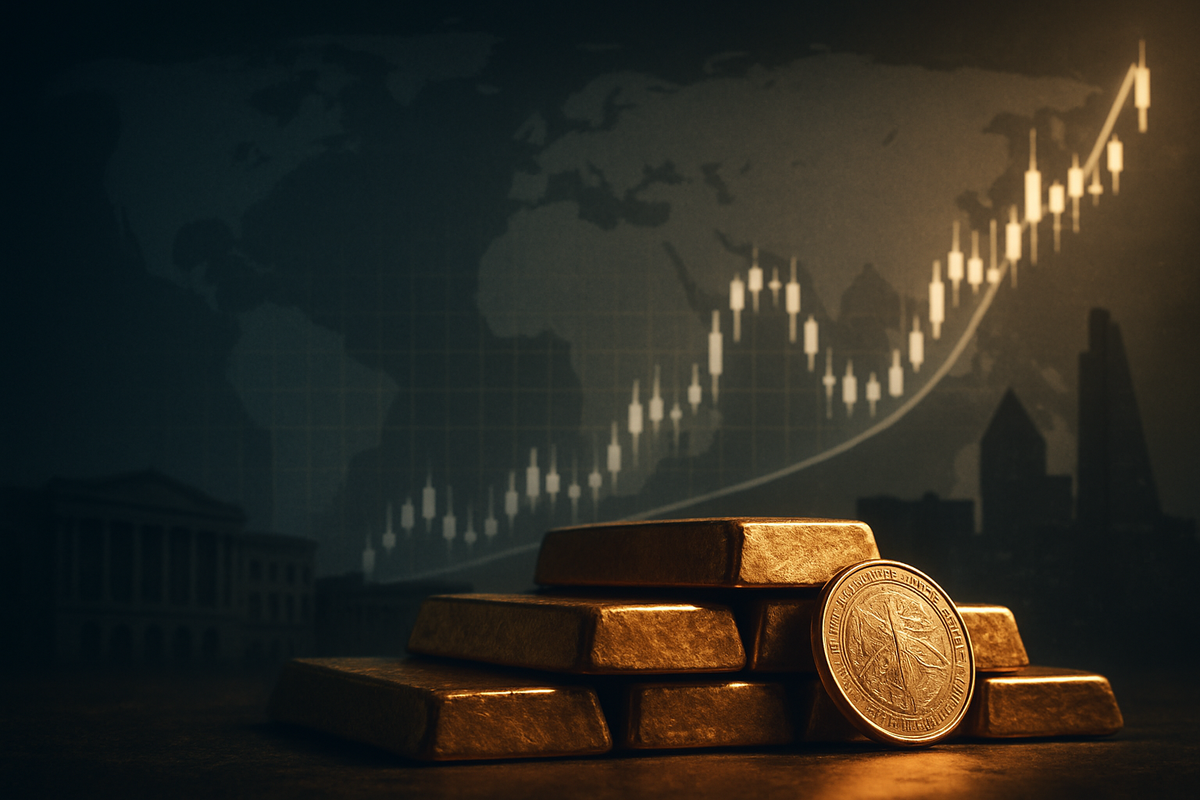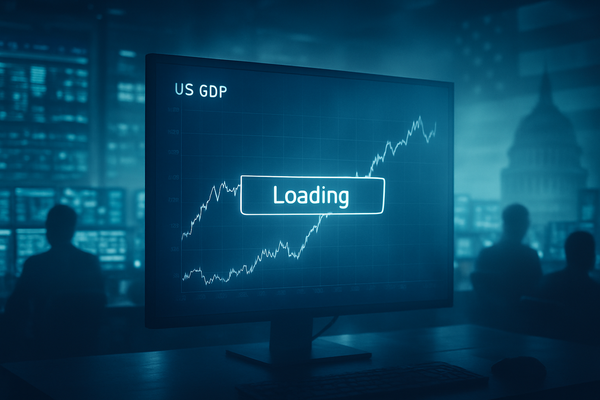Gold Soars Towards $5,000 as Inflation Fears Mount, Central Banks Buy Big, and Global Turmoil Fuels Safe-Haven Rush.

Gold prices are currently experiencing an unprecedented surge, with the precious metal recently hitting new all-time highs above $3,600 per ounce in September 2025. This remarkable upward trajectory is driven by a confluence of persistent global inflation, robust central bank demand, and its enduring status as a safe-haven asset amidst widespread geopolitical uncertainties. Projections from major financial institutions suggest that if these underlying factors persist or intensify, gold could continue its rally, potentially reaching the $4,000 to $5,000 range in the coming years.
This significant appreciation not only solidifies gold's position as a crucial hedge against the erosion of purchasing power but also signals a deeper recalibration of confidence in traditional financial assets and fiat currencies, particularly the US dollar. The implications of such a surge are far-reaching, impacting investment strategies, currency markets, the mining industry, and even global economic stability.
Gold's Historic Ascent: What Happened and Why It Matters
The price of gold has embarked on an extraordinary rally, recording a substantial 27% increase in 2024 and accelerating sharply in 2025, with a nearly 39% gain year-to-date. The precious metal began 2025 trading around $2,624-$2,657 per ounce and swiftly crossed the $3,000 milestone by March. After hitting a peak of $3,500 in April, the most dramatic movements unfolded in early September 2025. On September 8, spot gold surged past $3,600 for the first time, reaching an intraday record of $3,636.69, with futures briefly touching $3,639.10. The rally culminated in an all-time high of approximately $3,674 per ounce on September 9-10, and it has since traded near these record levels.
This monumental surge is underpinned by a powerful combination of factors. Persistent global inflation, exacerbated by factors like tariff-driven price increases and supply chain disruptions, continues to erode purchasing power, making gold an attractive store of value. Concurrently, central banks, particularly those in emerging markets like China and Poland, have been aggressively accumulating gold, with annual net purchases exceeding 1,000 metric tons for three consecutive years. This strategic shift is driven by a desire for diversification away from the US dollar, increased geopolitical uncertainty, and a need to build resilience in reserve portfolios while reducing exposure to sanctions risk. A June 2025 survey even indicated that 95% of central banks plan to increase their gold reserves in the next 12 months.
Furthermore, gold's traditional safe-haven status is particularly pronounced amidst current global turmoil. Escalating geopolitical tensions, including ongoing conflicts in the Middle East and Ukraine, coupled with trade disputes and concerns about a slowing US economy, foster a climate of uncertainty that encourages investors and central banks to seek safety in physical bullion. The expectation of impending interest rate cuts by the US Federal Reserve, driven by a cooling labor market, further boosts gold's appeal by reducing the opportunity cost of holding the non-yielding asset and potentially weakening the US dollar.
Initial market reactions reflect this profound shift. While the US dollar has weakened, bond markets have experienced turmoil, and stock markets have shown declines during periods of intensified uncertainty. Gold mining stocks have been identified as a "high-potential opportunity," with analysts noting their undervaluation relative to the soaring gold price. The sustained rally has prompted some institutions to propose a "new 60/40 investment portfolio" that elevates gold from a "peripheral asset" to a "core allocation," dedicating a significant portion to both "safe-haven gold" and "performance-oriented gold" (silver and mining stocks), signifying a potential paradigm shift in asset allocation strategies.
Mining for Fortune: Winners and Losers in the Golden Era
A sustained surge in gold prices towards the $4,000-$5,000 range would create clear winners and losers across various sectors, reflecting both direct and indirect impacts of this precious metal's ascent.
The Winners are primarily those directly involved in the gold industry. Gold mining companies stand to benefit immensely, as higher gold prices directly translate into increased revenue and expanded profit margins, given their relatively fixed production costs. This operational leverage can lead to a disproportionately larger increase in profits and cash flow, stimulating investment in exploration and expansion. Leading global producers such as Newmont Corporation (NYSE: NEM), Barrick Gold Corporation (NYSE: GOLD, TSX: ABX), and Agnico Eagle Mines Limited (NYSE: AEM, TSX: AEM) are poised for substantial boosts to their financials. Mid-tier miners like B2Gold Corp. (NYSE: BTG), Kinross Gold Corp (NYSE: KGC), and SSR Mining Inc. (NASDAQ: SSRM) would also see significant earnings and revenue growth.
Precious metals royalty and streaming companies are another major category of winners. These firms, which provide upfront financing to miners in exchange for future gold production or revenue, benefit from higher gold prices without incurring the direct operational risks and capital expenditures of mining. Their margins widen substantially as the value of the gold they receive increases while their costs remain stable. Key players include Franco-Nevada Corporation (NYSE: FNV, TSX: FNV), Wheaton Precious Metals Corp. (NYSE: WPM, TSX: WPM), and Royal Gold, Inc. (NASDAQ: RGLD). Furthermore, gold-backed Exchange Traded Funds (ETFs) such as SPDR Gold Shares (NYSE: GLD) and iShares Gold Trust (NYSE: IAU) would continue to attract significant inflows as investors seek direct exposure to gold's appreciation.
The Losers, while less directly impacted by gold's price itself, are often collateral damage of the underlying conditions driving gold higher, namely persistent inflation and economic uncertainty. Industries sensitive to inflation and reduced consumer discretionary spending would face headwinds. If inflation remains high, consumer purchasing power erodes, leading to cutbacks in non-essential goods and services, affecting sectors like retail, technology (especially consumer electronics), and hospitality. Companies like Signet Jewelers Limited (NYSE: SIG), a major mass-market jewelry retailer, could face challenges from both increased input costs and potential reduced demand for higher-priced items.
Moreover, industries that use gold as a key input would see their production costs surge. The jewelry industry, beyond luxury brands, would struggle with higher raw material costs, potentially leading to reduced demand or a shift towards lighter-weight or alternative metal products. The electronics, nanotechnology, and medical device industries, which rely on gold for its unique properties, would also face increased input costs, spurring a greater emphasis on cost-efficiency and innovation in gold usage. Finally, if the inflation driving gold's rise prompts central banks to aggressively hike interest rates, companies with high debt burdens would face increased borrowing costs, adding financial strain.
A System Under Pressure: Industry Impact and Broader Implications
A sustained gold price surge to $4,000-$5,000 per ounce signifies more than just a market rally; it indicates deep-seated shifts in global finance and economic stability. This phenomenon fits squarely into broader industry trends marked by an erosion of confidence in traditional financial systems, persistent inflationary pressures, and a notable re-evaluation of reserve assets by nations worldwide.
The ripple effects would be profound. In the gold mining industry, the surge would unleash a new wave of investment, driving exploration, development, and expansion, as profitability soars. This would not only boost the stock valuations of major mining companies but also attract significant capital to junior miners. Conversely, the jewelry industry would face a nuanced challenge. While luxury brands might weather the storm due to less price-sensitive clientele, mass-market jewelers like Signet Jewelers Limited (NYSE: SIG) would grapple with increased raw material costs, potentially leading to reduced consumer demand or a shift towards more affordable designs and materials. Industries relying on gold for industrial applications, such as electronics and dentistry, would also incur higher input costs, likely accelerating efforts to find alternative materials where feasible.
Regulatory and policy implications are significant. The aggressive accumulation of gold by central banks, particularly those in emerging markets, directly challenges the established order of dollar-centric reserve asset management. This trend underscores a global movement towards monetary sovereignty and a hedge against the perceived "weaponization" of the dollar-based financial system through sanctions. Governments, especially in countries with substantial gold markets like China and India, might implement policies to manage market dynamics, ensure transparency, and potentially reform state monopolies or streamline import/export regulations for gold. Furthermore, the reinforcement of gold's role as a Tier 1 asset under Basel III regulations could increase its appeal for financial institutions, impacting capital requirements and reserve management.
Historically, gold surges have often coincided with periods of significant economic upheaval. The 1970s stagflation, following the abandonment of the Bretton Woods system, saw gold prices soar, peaking at an inflation-adjusted equivalent of roughly $3,300 in 2025 dollars. Similar flights to safety occurred during the 2008 Global Financial Crisis and the initial phases of the COVID-19 pandemic. The current rally shares characteristics with these past events, driven by a unique blend of accommodative monetary policies, persistent inflation concerns, and escalating geopolitical tensions. However, the current environment is distinguished by the unprecedented and strategic gold accumulation by central banks, which provides a stronger, more structural underpinning for gold prices, suggesting this rally could be more sustained and fundamental than previous ones, potentially marking the beginning of a "super cycle."
The Golden Horizon: What Comes Next
The current trajectory of gold prices, driven by enduring inflation, relentless central bank demand, and its indisputable safe-haven appeal, positions the precious metal for further significant gains. Analysts widely anticipate gold to continue its ascent, making a comprehensive understanding of what comes next crucial for investors and policymakers alike.
In the short-to-medium term (2025-2026), the consensus among financial institutions remains strongly bullish. J.P. Morgan Research projects gold prices to average $3,675/oz by Q4 2025 and climb towards $4,000 by mid-2026. Goldman Sachs and UBS echo this sentiment, forecasting gold to reach $3,700 by late 2025 and $4,000 by mid-2026. This continued appreciation will be fueled by the anticipated Federal Reserve interest rate cuts, which reduce the opportunity cost of holding non-yielding gold, and the ongoing geopolitical instability that sustains safe-haven demand. Central banks are expected to maintain their high levels of gold purchases, providing a significant structural tailwind.
Looking towards the long-term (2026-2030 and beyond), the outlook suggests gold could reach and potentially surpass the $5,000 mark. This scenario is predicated on the continuation of aggressive central bank accumulation, a sustained environment of monetary accommodation from major central banks, growing sovereign debt, and potentially a fundamental shift in the global monetary system away from dollar dependency. Some more aggressive forecasts, like those from Goldman Sachs, suggest gold could hit $5,000 if private investors significantly increase their allocations or if a modest shift of private U.S. Treasury investments flows into gold. Extreme scenarios, such as a significant loss of faith in the US dollar or a perceived compromise of Federal Reserve independence, could accelerate a rally towards the upper end of these forecasts, fundamentally reshaping the global financial architecture.
Strategic pivots will be essential for investors. Gold's low correlation with other asset classes reinforces its role as an effective portfolio diversifier and an insurance during market downturns, with many experts now recommending a 5% to 15% allocation. A "buy on dips" strategy may prove effective, complementing a long-term holding approach. Beyond physical gold, investors can consider gold-backed ETFs or gold mining equities for leveraged exposure, while royalty companies offer a less volatile alternative. Key challenges include potential price volatility, the absence of cash flows from gold itself, and the risk of a strong US dollar or a resilient equity market diverting capital away from safe-haven assets. Ultimately, the coming years will be defined by how central banks manage inflation, how global geopolitical tensions evolve, and the enduring quest for monetary sovereignty among nations.
The Enduring Allure: Conclusion
The current gold surge is not merely a transient market phenomenon but a profound signal of shifting global economic and financial paradigms. With prices soaring past $3,600 per ounce and analysts forecasting a credible path to $4,000 and even $5,000, gold is unequivocally reaffirming its historical role as the ultimate store of value and a critical hedge in uncertain times.
The key takeaways from this unprecedented rally are clear: persistent inflation is eroding confidence in fiat currencies, prompting a flight to tangible assets; central banks are strategically diversifying their reserves away from the US dollar, cementing gold's role as a cornerstone of monetary sovereignty; and an environment of heightened geopolitical instability globally is driving an insatiable demand for safe havens. These powerful, interwoven forces create a robust and structural bull market for gold that appears poised to continue its upward trajectory.
Looking ahead, the market's assessment remains broadly bullish. While short-term volatility and periods of consolidation are possible, the long-term outlook for gold is strong. Its performance will be closely tied to the Federal Reserve's monetary policy decisions, global inflation trends, and the ongoing geopolitical landscape. The lasting impact of this surge could be a fundamental re-evaluation of gold's position within global financial architecture, potentially challenging the long-standing dominance of the US dollar as the world's primary reserve currency.
Investors should remain vigilant and closely monitor key indicators in the coming months. The pace and extent of Federal Reserve interest rate cuts, coupled with any shifts in inflation data, will be crucial. Geopolitical developments, particularly in conflict zones and trade relations, will continue to influence safe-haven demand. Furthermore, tracking central bank purchasing patterns and investor sentiment, as reflected in gold-backed ETF flows, will provide valuable insights. While gold offers significant opportunities for capital appreciation and portfolio diversification in this evolving environment, careful analysis, appropriate risk management, and a long-term perspective will be paramount for navigating what promises to be a defining era for the precious metal.



